- play_arrow Introduction
- play_arrow Overview
- play_arrow Access the Paragon Automation GUI
- play_arrow Access the Paragon Planner
- play_arrow Configure SMTP, LDAP, and Portal Settings
- play_arrow Manage Users
- play_arrow Manage Roles
- play_arrow Manage User Groups
- play_arrow Identity Providers
-
- play_arrow Integration With Anuta ATOM
- play_arrow Workflows
- play_arrow Base Platform
- play_arrow Paragon Pathfinder
- play_arrow Paragon Planner
- play_arrow Paragon Insights
-
- play_arrow Manage Devices and Network
- play_arrow Devices
- play_arrow Device Groups
- play_arrow Device Images
- play_arrow Network
- play_arrow Network Groups
- play_arrow Topology Filter
-
- play_arrow Manage Device Templates and Configuration Templates
- play_arrow Configuration Templates
- Configuration Templates Overview
- Configuration Templates Workflow
- About the Configuration Templates Page
- Add Configuration Templates
- Preview and Render a Configuration Template
- Assign Configuration Templates to a Device Template
- Deploy a Configuration Template to a Device
- Edit, Clone, and Delete a Configuration Template
- play_arrow Device Templates
-
- play_arrow Manage Sensor Settings, Insights Settings, and Data Summarization Profiles
- play_arrow Sensor Settings
- Sensors Overview
- About the Ingest Settings Page
- Configure NetFlow Settings
- Configure a Rule Using Flow Sensor
- About the Frequency Profiles
- Manage Frequency Profiles
- Apply a Frequency Profile
- Configure Offset Time
- Configure a Rule Using Server Monitoring Sensor
- Configure Native GPB Ingest
- Configure sFlow Settings
- Configure SNMP Ingest
- Configure a Rule Using SNMP Scalar
- Configure SNMP Trap and Inform Notifications
- Configure Outbound SSH Port for iAgent
- Configure System Log Ingest
- System Log Optional Configurations
- Configure a Rule Using Syslog
- Understand Inband Flow Analyzer 2.0
- Configure Device Details for Inband Flow Analyzer Devices
- Delete an Inband Flow Analyzer Device
- Understand Bring Your Own Ingest
- Load BYOI Default Plug-ins
- Configure Bring Your Own Ingest Default Plug-in Instances
- Build and Load BYOI Custom Plug-in Images
- Configure Bring Your Own Ingest Custom Plug-in Instances
- Use Sample Rule and Playbook Configurations for BYOI Custom Plug-in Instances
- Configure Ingest Mapping for Default BYOI Plug-in Instances
- Delete a BYOI Plug-in
- About the Diagnostics Page
- Use the Self Test Tool
- Use the Reachability Test
- Use the Ingest Test Tool
- Use the No-Data Tool
- Paragon Insights Tagging Overview
- Types of Tagging
- Add a Tagging Profile
- Apply a Tagging Profile
- Delete a Tagging Profile
- Understand User-Defined Actions and Functions
- Modify User-Defined Action, Function, and Workflow Engines
- Enable UDA Scheduler in Trigger Action
- Understand kube-state-metrics Service
- play_arrow Insights Settings
- About the Insights Settings Page
- Add Alert Blackouts
- About Alert Notifications
- Use Exim4 for E-mails
- Configure the Exim4 Agent to Send E-mail
- Configure a Notification Profile
- Enable Alert Notifications for Device Groups and Network Groups
- Configure Report Settings
- Configure Scheduler Settings
- Configure a Retention Policy
- Configure Destination Settings
- Time Series Database (TSDB) Overview
- Manage Time Series Database Settings
- Backup and Restore the TSDB
- Time Series Database Replication Scenarios
- play_arrow Data Summarization Profiles
-
- play_arrow Configure Your Network
- play_arrow Topology
- play_arrow Network Information Table
- Network Information Table Overview
- About the Node Tab
- Add a Node
- Edit Node Parameters
- Delete a Node
- About the Link Tab
- Add a Link
- Edit Link Parameters
- Delete a Link
- About the Tunnel Tab
- Understand How Pathfinder Handles LSPs
- Reroute LSPs Overview
- Segment Routing Overview
- Add a Single Tunnel
- Add Diverse Tunnels
- Add Multiple Tunnels
- Edit and Delete Tunnels
- About the Demand Tab
- About the Interface Tab
- Container LSP Overview
- About the Container LSP Tab
- Add a Container LSP
- Edit Container LSP Parameters
- Maintenance Event Overview
- About the Maintenance Tab
- Add a Maintenance Event
- Edit a Maintenance Event
- Simulate a Maintenance Event
- Delete a Maintenance Event
- About the P2MP Groups Tab
- Add a P2MP Group
- Edit P2MP Group Parameters
- About the SRLG/Facility Tab
- Add an SRLG/Facility
- Edit SRLG/Facility Parameters
- About the Topology Group Tab
- Add Anycast Group Tunnels
- play_arrow Tunnels
- play_arrow Change Control Management
-
- play_arrow Monitoring
- play_arrow Monitor Network Health
- play_arrow Manage Alarms and Alerts
- play_arrow Monitor Jobs
- play_arrow Analytics
- play_arrow Monitor Workflows
-
- play_arrow Reports
- play_arrow Health Reports
- play_arrow Network Reports
- play_arrow Maintenance Reports
- play_arrow Inventory Reports
- play_arrow Demand Reports
-
- play_arrow Administration
- play_arrow Manage E-mail Templates
- play_arrow Manage Audit Logs
- play_arrow Configure External EMS
- play_arrow Manage Task Scheduler
- play_arrow Manage Security Settings
- play_arrow License Management
-
Monitor Network Devices from the Charts Page
SUMMARY Read the following example configurations to understand the various ways you can monitor network devices from the Charts page.
You can use charts to monitor the status and health of your network devices. Charts allow you to visualize data collected by Paragon Insights from a device. For more information on creating charts and viewing charts, see Charts Overview.
Monitor Interface Flaps for a Single Interface
The following example configuration describes how you can monitor interface flaps for a single interface.
Playbook used: interface-kpis-playbook
Example graph configuration:
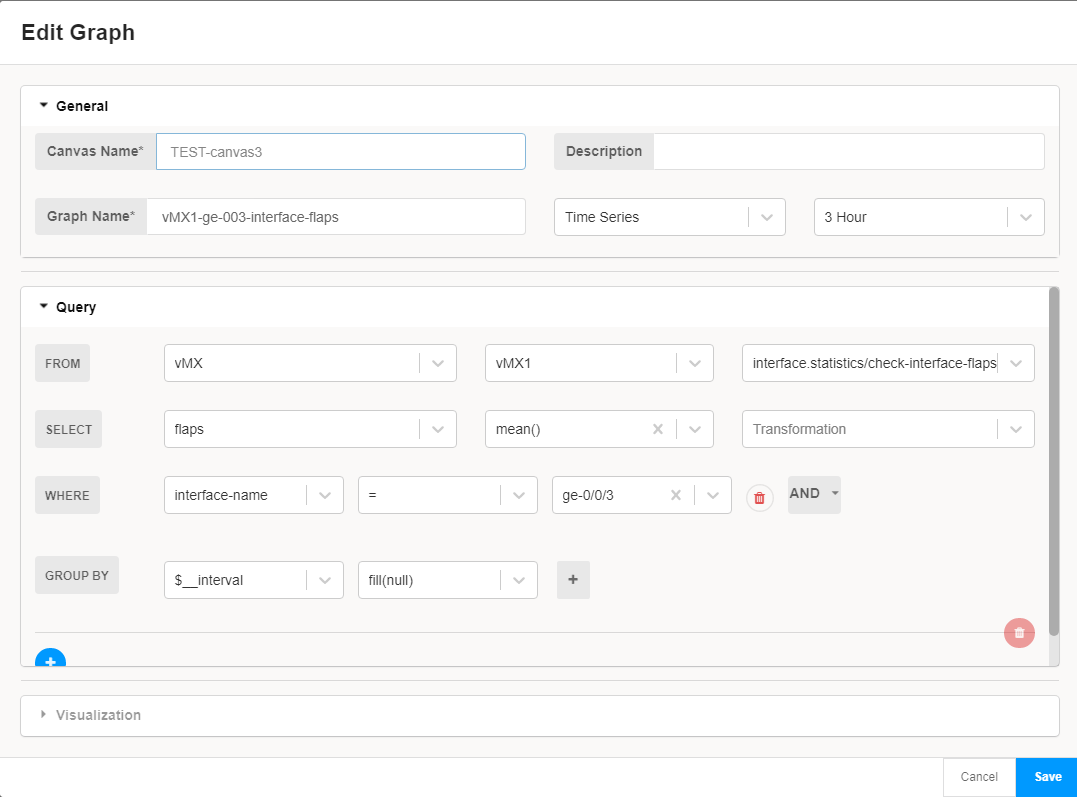
The example shows a configuration for vMX1 device in a canvas titled Test-canvas3. The query section takes interface flap count (flaps) as field input and computes the mean for flaps in ge-0/0/3 interface. The time series graph in the configuration is captured over 3 hours.
In the Query section, the FROM fields show the input for device-group name, device name, and rule, respectively.
The SELECT fields contain inputs for a KPI key based on the rule you set earlier. If the rule you selected is
interface.statistics/check-interface-flaps, the SELECT field could show options for flap count, flap threshold, and so on.The Aggregation field describes data aggregation computation to be performed on the KPI field data (flap counts in this example) such as mean, median, sum, and so on.
The Transformation field (optional) describes computations performed on subsequent values in a single field. For example, rate of change, elapsed time, differences, and so on.
The WHERE section allows you to set a condition to filter the field data. You must enter a left operand, a right operand, and a conditional operand such as equal to, matches with, greater than, less than, and so on. The left operand can be either a key or a field name.
In the example configuration, the condition defined checks if the interface-name is equal to ge-0/0/3.
The GROUP BY section allows you to group the filtered data by a time interval you specify and handle output value in cases where no field data is available. You can choose group by time interval from the drop-down list.
If you set the time interval in GROUP BY field as $_interval, then Grafana sets the time interval for data aggregation based on the number of points received in the time series database (TSDB).
In the Visualization section, you can enter the y-axis minimum and maximum values, y-axis label and choose a unit such as bytes, kilobytes, and so on.
In this example configuration, the Visualization section is not configured.
Sample graph panel output:

The graph shows interface flaps for ge/0/0/3 interface in device vMX1.
Monitor Interface Flaps for ’ge’ Interfaces on a Device
The following example configuration describes how you can monitor interface flaps for all ’ge’ interfaces on a device in a single graph.
Playbook used: interface-kpis-playbook
Example graph configuration:
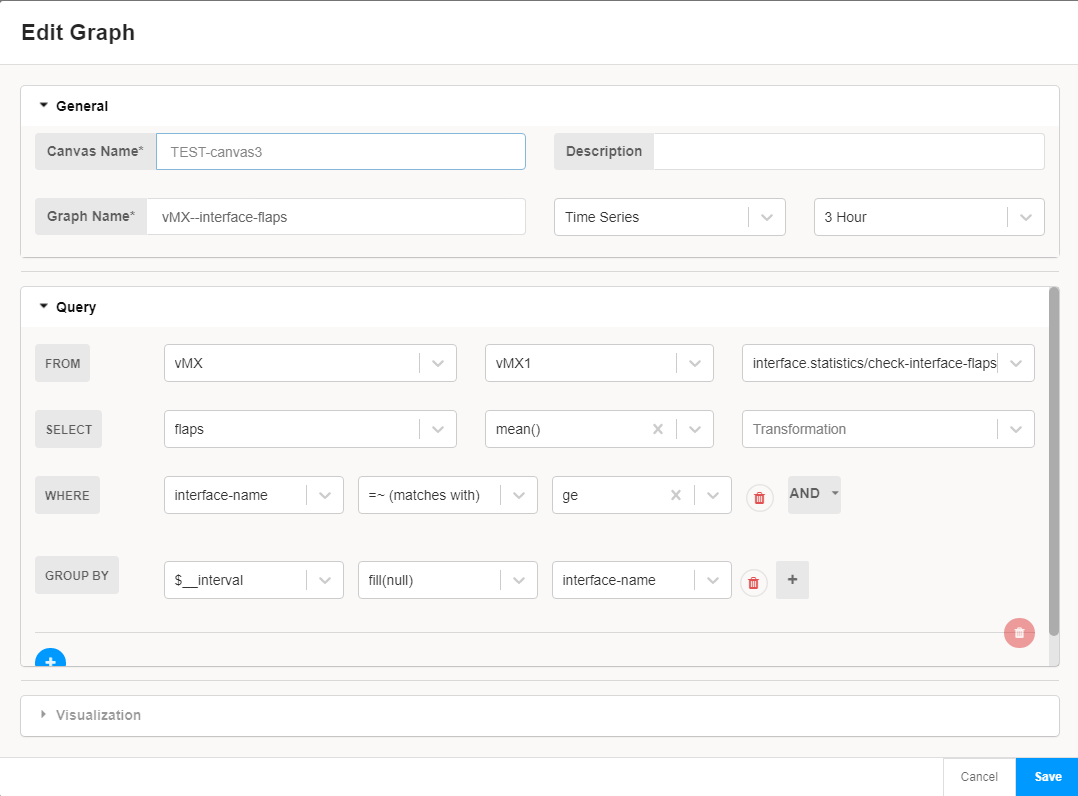
The example shows the configuration for vMX1 device in a canvas titled Test-canvas3. The query section takes interface flap count (flaps) as field input and computes the mean for flaps in all ge interfaces. The time series graph in the configuration is captured over 3 hours.
In the Query section, the FROM fields shows the input for device-group name, device name, and rule, respectively.
The SELECT fields contain inputs for a KPI key based on the rule that you set earlier. If the rule you selected is
interface.statistics/check-interface-flaps, the SELECT field could show options for flap count, flap threshold, and so on.The Aggregation field describes data aggregation computation to be performed on the KPI field data (flap counts in this example) such as mean, median, sum, and so on.
The Transformation field (optional) describes computations performed on subsequent values in a single field. For example, rate of change, elapsed time, differences, and so on.
The WHERE section allows you to set a condition to filter the field data. You must enter a left operand, a right operand and a conditional operand such as equal to, matches with, greater than, less than, and so on. The left operand can be either a key or a field name.
In the example configuration, the condition defined checks if the interface-name matches with ge.
The GROUP BY section allows you to group the filtered data by a time interval you specify and handle output value in cases where no field data is available. You can choose group by time interval from the drop-down list.
If you set the time interval in GROUP BY field as $_interval, then Grafana sets the time interval for data aggregation based on the number of points received in TSDB.
In the Visualization section, you can enter the y-axis minimum and maximum values, y-axis label and choose unit such as bytes, kilobytes, and so on.
In this example configuration, the Visualization section is not configured.
Sample graph panel output:

The graph shows flap counts of three ge interfaces — ge-0/0/0, ge0/0/1, and ge-0/0/2 in the vMX1 device.
Monitor System Memory Usage of all Devices in a Device Group
The following example configuration describes how you can monitor system memory usage for all devices in a device group in a single graph.
Playbook used: system-kpis-playbook
Example graph configuration:
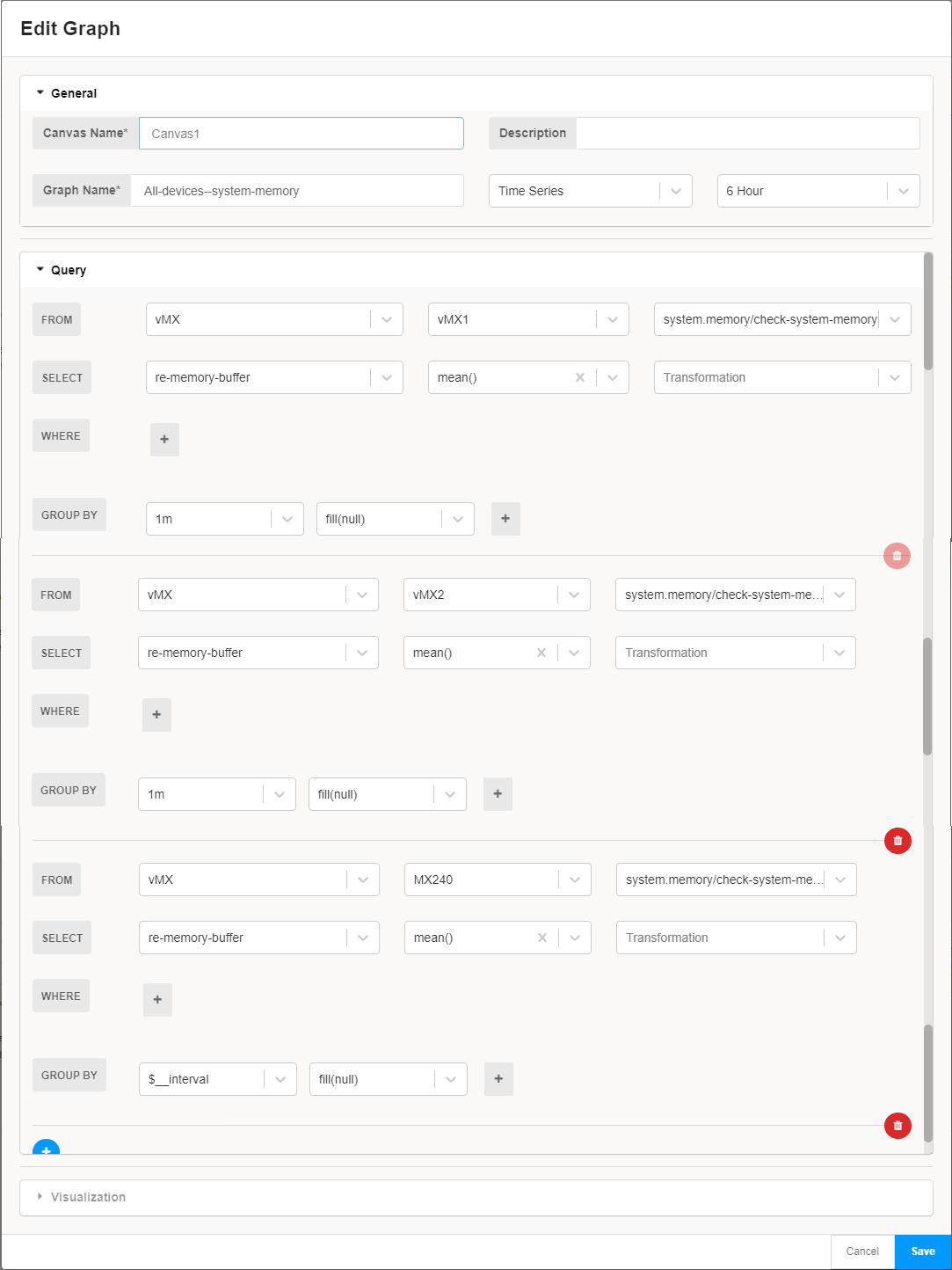
This example configuration shows the query section configured for three devices — vMX1, vMX2, and MX240 — in a single canvas titled Canvas1. The query section takes the routing engine’s system memory buffer (re-memory-buffer) as field input, computes mean for a time interval set by the user or Grafana. The example configuration is set for the time series graph captured over 6 hours.
In the Query section, the FROM fields show the input for device-group name, device name, and rule, respectively.
The SELECT fields contain inputs for a KPI key based on the rule you set earlier. If the rule you selected is
system.memory/check-system-memory, the SELECT field could show options for system memory buffer value, system memory high threshold, system memory low threshold, and so on.The Aggregation field describes data aggregation computation to be performed on the KPI field data (system memory buffer in this example) such as mean, median, sum, and so on.
The Transformation field (optional) describes computations performed on subsequent values in a single field. For example, rate of change, elapsed time, differences, and so on.
The WHERE section allows you to set a condition to filter the field data. You must enter a left operand, a right operand and a conditional operand such as equal to, matches with, greater than, less than, and so on. The left operand can be either a key or a field name.
In this example, no conditions are set in the WHERE section.
The GROUP BY section allows you to group the filtered data by a time interval you specify and handle output value in cases where no field data is available. You can choose group by time interval from the drop-down list.
If you set the time interval in GROUP BY field as $_interval, then Grafana sets the time interval for data aggregation based on the number of points received in TSDB.
In this example configuration, the group by interval is set at 1 minute for vMX1 and vMX2 devices whereas, Grafana would decide the time interval to group by aggregated data for MX240 device.
In the Visualization section, you can enter the y-axis minimum and maximum values, y-axis label and choose unit such as bytes, kilobytes, and so on.
In this example configuration, the Visualization section is not configured.
Sample graph panel output:

The graph shows mean system memory buffer values aggregated per minute for vMX1 and vMX2, and for an unknown time interval for MX240 device.
Monitor RE CPU Usage for Multiple Devices
The following example configuration describes how you can monitor RE CPU usage for multiple devices in a single graph.
Playbook used: system-kpis-playbook
Example graph configuration:
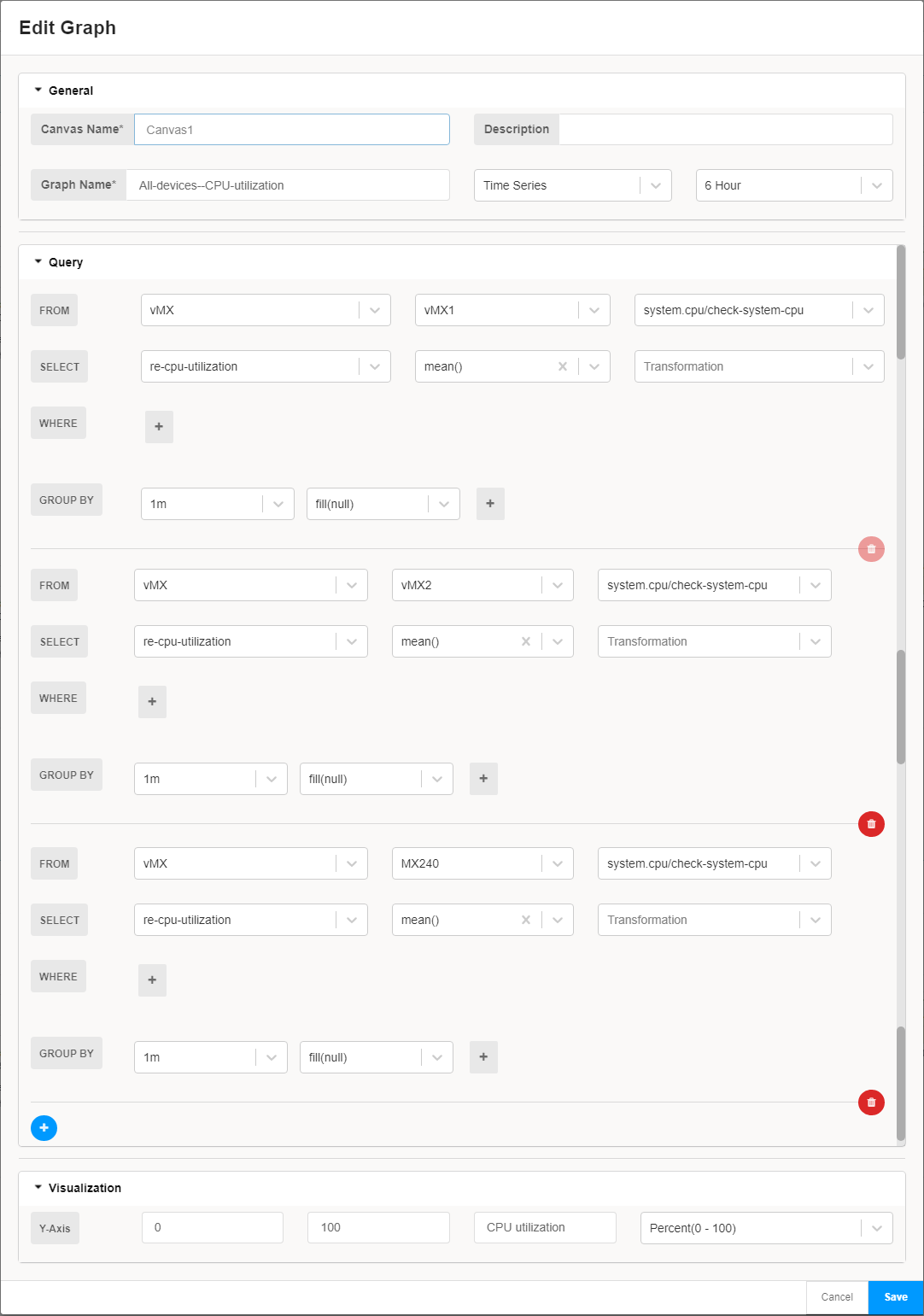
This example configuration shows the query section and visualization section configured for three devices — vMX1, vMX2, and MX240 — in a single canvas titled Canvas1. The query section takes the routing engine’s CPU utilization (re-cpu-utilization) as field input, computes the mean every minute for the three devices, and visualizes the mean CPU utilization per minute as percentage. The example configuration is set for the time series graph captured over 6 hours.
In the Query section, the FROM fields shows the input for device-group name, device name, and rule, respectively.
The SELECT fields contain inputs for a KPI key based on the rule that you set earlier. If the rule you selected is
system.cpu/check-system-cpu, the SELECT field could show options for CPU utilization value, CPU utilization high threshold, CPU utilization low threshold, and so on.The Aggregation field describes data aggregation computation to be performed on the KPI field data (CPU utilization in this example) such as mean, median, sum, and so on.
The Transformation field (optional) describes computations performed on subsequent values in a single field. For example, rate of change, elapsed time, differences, and so on.
The WHERE section allows you to set a condition to filter the field data. You must enter a left operand, a right operand and a conditional operand such as equal to, matches with, greater than, less than, and so on. The left operand can be either a key or a field name.
In this example, no conditions are set in the WHERE section.
The GROUP BY section allows you to group the filtered data by a time interval you specify and handle output value in cases where no field data is available. You can choose group by time interval from the drop-down list.
If you set the time interval in GROUP BY field as $_interval, then Grafana sets the time interval for data aggregation based on the number of points received in TSDB.
In this example configuration, the group by interval is set at 1 minute for vMX1, vMX2, and MX240 devices.
In the Visualization section, you can enter the y-axis minimum and maximum values, y-axis label and choose unit such as bytes, kilobytes, and so on.
In this example configuration, the y-axis range for mean CPU utilization per minute is set on a scale of 0 to 100 percentage.
Sample graph panel output:

The graph displays mean CPU utilization in percentage for vMX1, vMX2, and MX240 devices.
Monitor RE CPU Usage for Multiple Devices side-by-side
The following example configuration describes how you can monitor RE CPU usage for multiple devices side-by-side.
Playbook used: system-kpis-playbook
Example graph configurations:
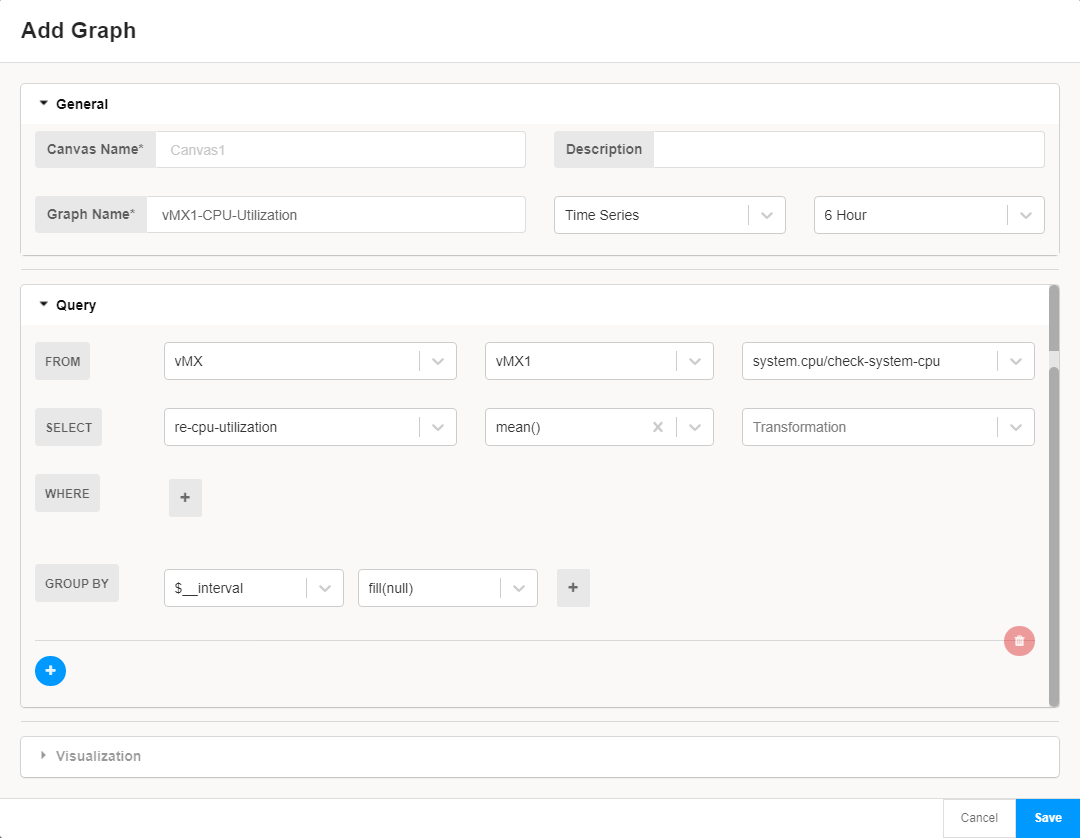

This example shows separate configurations for two devices — vMX1 and MX240 — in a single canvas titled Canvas1. The query section takes routing engine’s CPU utilization (re-cpu-utilization) as field input, computes the mean every minute for the three devices. These example configurations are set for the time series graph captured over 6 hours.
In the Query section, the FROM fields shows the input for device-group name, device name, and rule, respectively.
The SELECT fields contain inputs for a KPI key based on the rule that you set earlier. If the rule you selected is
system.cpu/check-system-cpu, the SELECT field could show options for CPU utilization value, CPU utilization high threshold, CPU utilization low threshold, and so on.The Aggregation field describes data aggregation computation to be performed on the KPI field data (CPU utilization in this example) such as mean, median, sum, and so on.
The Transformation field (optional) describes computations performed on subsequent values in a single field. For example, rate of change, elapsed time, differences, and so on.
The WHERE section allows you to set a condition to filter the field data. You must enter a left operand, a right operand and a conditional operand such as equal to, matches with, greater than, less than, and so on. The left operand can be either a key or a field name.
In this example, no conditions are set in the WHERE section.
The GROUP BY section allows you to group the filtered data by a time interval you specify and handle output value in cases where no field data is available. You can choose group by time interval from the drop-down list.
If you set the time interval in GROUP BY field as $_interval, then Grafana sets the time interval for data aggregation based on the number of points received in TSDB.
In the Visualization section, you can enter the y-axis minimum and maximum values, y-axis label and choose unit such as bytes, kilobytes, and so on.
In these example configurations, the Visualization section is not configured.
Sample graph panel output for two configurations:

The canvas titled Canvas1 has two graphs (because of two separate configurations) for the vMX1 and MX240 devices side-by-side.
